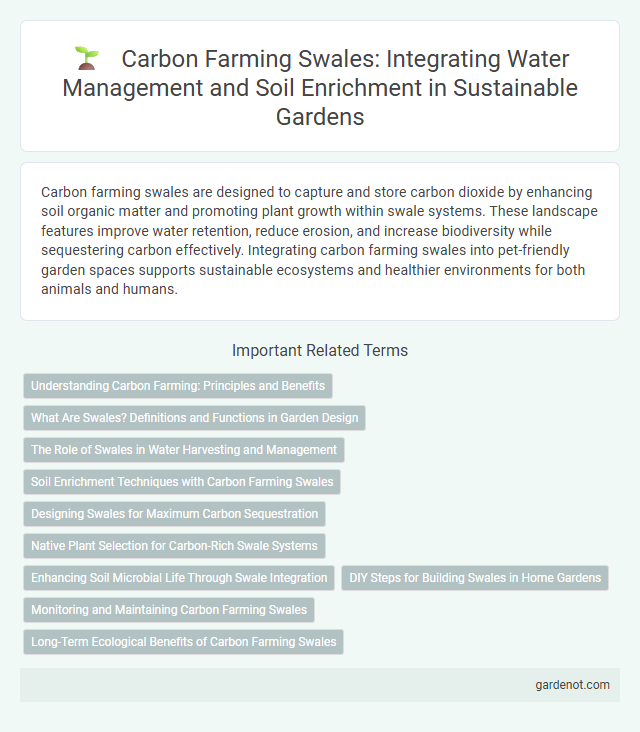Carbon farming swales are designed to capture and store carbon dioxide by enhancing soil organic matter and promoting plant growth within swale systems. These landscape features improve water retention, reduce erosion, and increase biodiversity while sequestering carbon effectively. Integrating carbon farming swales into pet-friendly garden spaces supports sustainable ecosystems and healthier environments for both animals and humans.
Understanding Carbon Farming: Principles and Benefits
Carbon farming in swales involves capturing and storing atmospheric carbon dioxide through targeted land management practices that enhance soil organic matter and promote vegetation growth. Swales function as key landscape features that slow water runoff, increase soil moisture, and support tree and plant growth, which sequester carbon dioxide and improve ecosystem health. Implementing carbon farming techniques in swales contributes to climate change mitigation, soil fertility enhancement, and biodiversity preservation.
What Are Swales? Definitions and Functions in Garden Design
Swales are shallow, elongated ditches strategically designed in garden landscapes to capture and infiltrate rainwater, promoting carbon farming through enhanced soil moisture retention and biomass growth. These earthworks support renewable organic matter accumulation, increasing soil carbon sequestration while reducing erosion and runoff. Integrating swales in permaculture systems optimizes microclimates for plants, contributing to sustainable carbon cycling and improved ecosystem resilience.
The Role of Swales in Water Harvesting and Management
Swales play a crucial role in carbon farming by enhancing water harvesting and management through their design as shallow, vegetated channels that slow runoff and promote groundwater infiltration. By capturing and retaining rainwater, swales reduce soil erosion, improve moisture availability for plants, and increase soil organic carbon storage. This water management technique supports healthier ecosystems and boosts carbon sequestration in agricultural landscapes.
Soil Enrichment Techniques with Carbon Farming Swales
Carbon farming swales enhance soil enrichment by capturing and retaining water, promoting deeper root growth and increased organic matter accumulation. These swales facilitate carbon sequestration by supporting microbial activity and vegetation that converts atmospheric carbon into stable soil carbon compounds. Implementing contour-based swales improves soil fertility, moisture retention, and long-term carbon storage, advancing sustainable land management practices.
Designing Swales for Maximum Carbon Sequestration
Designing swales for maximum carbon sequestration involves optimizing soil structure and moisture retention to enhance organic matter buildup and microbial activity. Incorporating deep-rooted native plants in swale design increases carbon input into the soil through root biomass and litter fall. Consistent maintenance and careful contouring improve water infiltration, reducing erosion and promoting long-term carbon storage in the soil.
Native Plant Selection for Carbon-Rich Swale Systems
Selecting native plants for carbon-rich swale systems enhances soil carbon sequestration by promoting deep root growth and organic matter accumulation. Species such as switchgrass (Panicum virgatum), black-eyed Susan (Rudbeckia hirta), and eastern gamagrass (Tripsacum dactyloides) improve soil structure and microbial diversity, accelerating carbon storage. Integrating drought-tolerant and nitrogen-fixing native plants optimizes swale performance while supporting local biodiversity and ecosystem resilience.
Enhancing Soil Microbial Life Through Swale Integration
Implementing swales in carbon farming significantly enhances soil microbial life by creating optimal moisture retention and aeration conditions, which promote microbial diversity and activity. These microhabitats increase organic matter decomposition and nutrient cycling, leading to improved soil fertility and carbon sequestration. Enhanced microbial ecosystems in swale-integrated landscapes contribute to resilient agroecological systems and sustained carbon capture in the soil.
DIY Steps for Building Swales in Home Gardens
Building swales for carbon farming in home gardens involves identifying contour lines to effectively capture and retain water, which enhances soil moisture and promotes carbon sequestration. Dig trenches along these contours and use the excavated soil to form berms on the downhill side, creating natural barriers that reduce erosion and encourage plant growth. Incorporate native plants and organic mulch on swales to improve soil fertility and maximize carbon storage while supporting biodiversity.
Monitoring and Maintaining Carbon Farming Swales
Monitoring and maintaining carbon farming swales involves regular assessment of soil carbon levels using soil sampling and spectroscopy to ensure effective carbon sequestration. Maintaining swales requires managing vegetation cover, preventing erosion, and adjusting water flow to optimize soil moisture and nutrient retention. Continuous data collection through remote sensing and on-site inspections helps detect changes in soil health and swale performance, supporting adaptive management practices.
Long-Term Ecological Benefits of Carbon Farming Swales
Carbon farming swales enhance soil carbon sequestration by capturing and retaining water, promoting microbial activity, and supporting diverse plant growth. These ecological structures reduce erosion, increase groundwater recharge, and improve habitat quality, contributing to resilient ecosystems. Over time, carbon farming swales foster sustainable land management practices that mitigate climate change impacts and restore degraded landscapes.
Carbon farming swale Infographic

 gardenot.com
gardenot.com